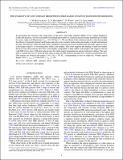| dc.contributor.author | MacLachlan, J. M. | |
| dc.contributor.author | Wood, K. | |
| dc.contributor.author | Gallagher, J. S. | |
| dc.contributor.author | Matthews, Lynn D. | |
| dc.date.accessioned | 2015-02-26T16:38:52Z | |
| dc.date.available | 2015-02-26T16:38:52Z | |
| dc.date.issued | 2011-10 | |
| dc.date.submitted | 2011-03 | |
| dc.identifier.issn | 0004-637X | |
| dc.identifier.issn | 1538-4357 | |
| dc.identifier.uri | http://hdl.handle.net/1721.1/95658 | |
| dc.description.abstract | To investigate the structure and composition of the dusty interstellar medium (ISM) of low surface brightness (LSB) disk galaxies, we have used multi-wavelength photometry to construct spectral energy distributions for three low-mass, edge-on LSB galaxies (V [subscript rot] = 88-105 km s[superscript –1]). We use Monte Carlo radiation transfer codes that include the effects of transiently heated small grains and polycyclic aromatic hydrocarbon molecules to model and interpret the data. We find that, unlike the high surface brightness galaxies previously modeled, the dust disks appear to have scale heights equal to or exceeding their stellar scale heights. This result supports the findings of previous studies that low-mass disk galaxies have dust scale heights comparable to their stellar scale heights and suggests that the cold ISM of low-mass, LSB disk galaxies may be stable against fragmentation and gravitational collapse. This may help to explain the lack of observed dust lanes in edge-on LSB galaxies and their low current star formation rates. Dust masses are found in the range (1.16-2.38) × 10[superscript 6] M [subscript ☉], corresponding to face-on (edge-on), V-band, optical depths 0.034 [< over ~] τ[subscript face] [< over ~] 0.106 (0.69 [< over ~] τ[subscript eq] [< over ~] 1.99). | en_US |
| dc.description.sponsorship | Jet Propulsion Laboratory (U.S.) (Contract 1279242) | en_US |
| dc.description.sponsorship | Alfred P. Sloan Foundation | en_US |
| dc.description.sponsorship | National Science Foundation (U.S.) | en_US |
| dc.description.sponsorship | United States. Dept. of Energy | en_US |
| dc.description.sponsorship | United States. National Aeronautics and Space Administration | en_US |
| dc.description.sponsorship | Max Planck Society for the Advancement of Science | en_US |
| dc.description.sponsorship | Japanese Monbukagakusho | en_US |
| dc.description.sponsorship | Higher Education Funding Council for England | en_US |
| dc.language.iso | en_US | |
| dc.publisher | IOP Publishing | en_US |
| dc.relation.isversionof | http://dx.doi.org/10.1088/0004-637x/741/1/6 | en_US |
| dc.rights | Article is made available in accordance with the publisher's policy and may be subject to US copyright law. Please refer to the publisher's site for terms of use. | en_US |
| dc.source | American Astronomical Society | en_US |
| dc.title | THE STABILITY OF LOW SURFACE BRIGHTNESS DISKS BASED ON MULTI-WAVELENGTH MODELING | en_US |
| dc.type | Article | en_US |
| dc.identifier.citation | MacLachlan, J. M., L. D. Matthews, K. Wood, and J. S. Gallagher. “THE STABILITY OF LOW SURFACE BRIGHTNESS DISKS BASED ON MULTI-WAVELENGTH MODELING.” The Astrophysical Journal 741, no. 1 (October 7, 2011): 6. © 2011 The American Astronomical Society | en_US |
| dc.contributor.department | Haystack Observatory | en_US |
| dc.contributor.mitauthor | Matthews, Lynn D. | en_US |
| dc.relation.journal | Astrophysical Journal | en_US |
| dc.eprint.version | Final published version | en_US |
| dc.type.uri | http://purl.org/eprint/type/JournalArticle | en_US |
| eprint.status | http://purl.org/eprint/status/PeerReviewed | en_US |
| dspace.orderedauthors | MacLachlan, J. M.; Matthews, L. D.; Wood, K.; Gallagher, J. S. | en_US |
| mit.license | PUBLISHER_POLICY | en_US |
| mit.metadata.status | Complete | |
